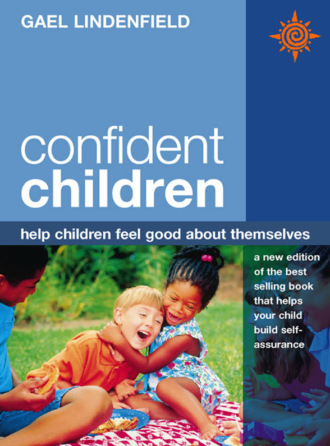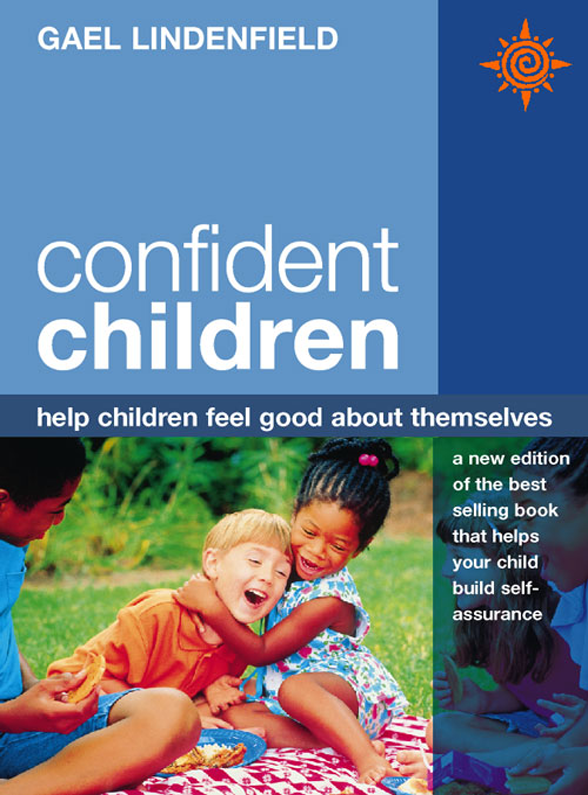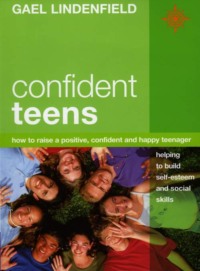
Полная версия
Confident Children: Help children feel good about themselves


Confident
Children
help children feel good about themselves
Gael Lindenfield


Dedication
To Laura, my daughter, with deepest love, constant admiration and unending gratitude for enriching my life and teaching me so much about parenting.
Tragically, in 1996, Laura was killed in a car accident at the age of 19. In her memory, Gael and her family set up a foundation (The Laura Lindenfield Foundation) to help young people find and follow an achievable life-dream.
Contents
Cover
Title Page
Dedication
List of Exercises
Introduction
Introduction to this Revised Edition
Part 1 You Will Never be a Perfect Parent But You Can Become a Confident One!
1 What Exactly is Confidence? Everything You Need to Know
2 How to Become a Good-enough Parent. More Saint, Less Sinner!
3 Providing a Helpful Environment. Confidence at Home
4 Your Family Life. Does it Hinder or Help?
Part 2 How to Lay the Foundations of Inner Confidence
5 Building Self-esteem. Help Your Children to Love Themselves
6 Developing Good Self-knowledge. Help your Children to Get to Know Themselves
7 Setting Goals. Help your Children to Reach for Their Stars
8 Thinking Positively. Negative Thinking is a Bad Habit – Help Your Children to Kick It!
Part 3 How to Improve Your Child’s Outer Confidence
9 Good Communication and Self-presentation. Learning the Essential Skills
10 Assertiveness. Helping Your Children to Find their Voices
11 Children and Emotions. Helping them to Manage their Feelings
12 Positive Problem-solving. Dealing with Difficulties Constructively
13 Dealing with Conflict. If You Want Confident Children, You Have to Deal with the Conflict!
14 The Flight to the Outside World. Giving your Children the Confidence to Survive on Their Own
Further Reading
Index
The Laura Lindenfield Foundation
Acknowledgements
By the Same Author
Copyright
About the Publisher
List of Exercises
Discovering my auto-parent
Sabotaging behaviours of my inner child
Recovering my dreams
Action plan to upgrade my knowledge
My stress warning signals
Action plan for stress prevention
Home-check
Family check-over
Building self-esteem
Helping my children to get to know themselves
My children’s goals
Encouraging positive thinking
Improving communication and presentation
Encouraging assertiveness
Managing feelings
Problem-solving
Dealing with conflict
Introduction
Have you ever found yourself feeling jealous of a pheasant? I did, just a few months ago. I was visiting our local zoo, which specializes in breeding and taking care of endangered species, and I came across a beautiful rare pheasant. When I read the note on her cage, I felt a surge of envy. It seems that this lucky bird was currently being given a chance to ‘practise her parenting skills’ by temporarily caring for a number of surrogate chicks. I turned to my husband and said, ‘It’s not fair – all my practice had to take place on Susie and Laura!’
This book is an attempt to provide a more considered, adult response to my concerns about the dangers of ‘not good-enough’ parenting. For many years I have been surrounded by evidence that has convinced me that, in this fast-changing, complex, competitive jungle of a world there is another endangered species – the confident parent! I wonder if you have ever met one: I am talking about a relaxed, guilt-free creature who seems naturally and effortlessly to be able to produce a complete breed of equally happy, confident and competent children. Like me, you are probably much more familiar with the kind of parents who spend a considerable amount of time worrying about whether they are ‘getting it right’, or feeling guilty because they know that they are often ‘getting it wrong’!
Is the problem that we now know too much? Should we simply burn those child psychology books and parenting magazines which have raised our expectations of good-enough parenting to seemingly impossible heights?
I don’t think so, because even though the image of the carefree cave-parent is sometimes very tempting, I cannot believe that either children or parents would have much to gain from turning the clock back. As you have chosen to read this book, I am assuming that you also believe that we now have a responsibility to use the knowledge and wisdom our culture has given us to develop and improve the emotional well-being of our children.
The suggestions and strategies in this book are offered as constructive alternatives to the paralysing anxiety and self-reproach which often seem to attack us when, in spite of our loving efforts, our children behave in a way which could indicate that their confidence is at a low ebb. For example, if we find that they are showing signs of:
– clinging on too long to ‘babyish habits’ such as thumb-sucking or bed-wetting
– under-achieving at school because they are too timid to ask for help or they feel lonely
– getting over-concerned with their work and requiring it to be too perfect
– becoming reluctant to venture from the safety of their home or town
– being frustratingly unable to make up their mind or give an opinion
– becoming immobilized with anxiety, fears, phobias or obsessions
– waking each night with frightening nightmares
– behaving shyly or inappropriately at social occasions
– becoming over-sensitive to criticism or teasing
– developing physical symptoms of stress such as headaches, nausea, or skin rashes
– showing off or bullying
– becoming persistently jealous or envious of others
– rejecting compliments and giving themselves put-downs
– losing their appetite or compulsively bingeing
In spite of being super-conscious of the vast numbers of parents who are crying out for help and guidance to help them tackle (or, indeed, prevent) such common problems, I had some initial misgivings about writing this book. First, you may be comforted to know that I was all too aware of my own mistakes as a mother. Secondly, I was working against a deeply held sense of mistrust in parenting ‘bibles’, which I believed could inhibit parents from using their natural nurturing intuition. After some reflection, I came to the conclusion that in an ideal world pheasants would not need parenting practice and humans might not need books such as this, but in the meantime there was very little excuse for not sharing my own personal and professional insights.
Who is this book for?
I have written this self-help programme for any thoughtful parents who are keen to build their children’s confidence. Although it contains many tips and guidelines, it has never been my intention that any of the material in this book should be used by robots looking for categorical operating instructions!
I anticipate that this book may also make interesting reading for many people who are in loco parentis (such as partners of parents, grandparents, child-minders, teachers and youth workers); it could also be used as a resource for professionals who are engaged in teaching parenting skills.
Finally, much of the material in the last half of this book (e.g. guidelines on successful communication and assertiveness) may also be of direct interest to older children.
What this book offers







How to use this book
As I have already indicated, this book is designed as an ongoing self-help programme. You will probably gain most benefit from first reading it through relatively quickly and then returning to it for a second reading at a slower pace, giving yourself time to do the exercises and to try out the guidelines and suggestions.
If you are ‘in partnership’ with a co-parent, ideally it would be best if you were to work even more slowly through the book together. Rarely do two people ever fully agree on parenting issues and, to some degree, this is a fact of life (albeit an uncomfortable one) which both children and parents must learn to accept and respect. But working jointly on this programme will at least give you a chance to discuss, argue and, hopefully, agree on some basic joint strategies and approaches.
Because this book has been written quite generally for parents with children of varying ages and abilities, you may sometimes need to ‘translate’ the text and adapt the exercises to suit your specific needs, your particular children and the culture in which you are living.
Finally, I hope that once you have completed the programme you will find this book a useful and supportive reference to refer to from time to time while your children are growing up. Please remember that it should be seen first and foremost as your resource, to be adapted and modified to suit your needs. I know from my own experience that reading books like this often stimulates my thinking and creativity, so if you come up with any new ideas as you read, please keep me informed!
Introduction to this Revised Edition
People often ask me ‘which book are you most proud of?’ I always reply, without hesitation, Confident Children. This is because it was, by far, the hardest one to write. It was (and still is!) the greatest challenge to the perfectionist demon that resides within me.
I remember the day I gave the completed manuscript to my 16-year-old daughter Laura to read as though it was yesterday. I was terrified that she might not like it. Without my two daughters’ approval I knew that, even though I had put my heart and soul into the book, I would not send it off for publication. I had to know that at the very least, I had (most of the time) practised what I was preaching.
Its next major test took very much longer. It had to prove itself as a practical tool. Thankfully, the wonderful feedback which I have received from parents all over the world over the last six years has assured me that the pain of its creation was certainly worthwhile.
But, nevertheless, I approached the task of updating it with renewed trepidation. I knew that the issue of confidence building for children was becoming even more important in today’s ever-increasingly tough competitive global age. I was also aware that during the last six years, there have been many cultural changes (such as the increase in dual working parents and non-conventional family groupings), which have brought even more stress to the difficult role of parenting.
I need not have worried, however, because I have thoroughly enjoyed re-visiting and updating the book. I hope you will find this new edition helpful and motivating and that the process of nurturing your children’s confidence is as rewarding for you as it was for me.
Конец ознакомительного фрагмента.
Текст предоставлен ООО «ЛитРес».
Прочитайте эту книгу целиком, купив полную легальную версию на ЛитРес.
Безопасно оплатить книгу можно банковской картой Visa, MasterCard, Maestro, со счета мобильного телефона, с платежного терминала, в салоне МТС или Связной, через PayPal, WebMoney, Яндекс.Деньги, QIWI Кошелек, бонусными картами или другим удобным Вам способом.










